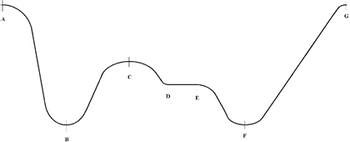Answer all questions since this is just one question, and not multiple, you just have to highlight the correct word for the questions. Ive read the honor code and it states that their can be up to three sub-questions on each single questions. So please answer all the questions provided, thank you.
A bead slides on a wire, which is in a vertical plane, as shown in the diagram. Gravity acts in the −y direction. The bead starts at point A, moving to the right with an initial velocity v. The wire is frictionless between A and D and between F and G, but there is friction between D and F.
The bead's potential energy at B is its potential energy at F.
a. Equal to
b. Needs more info
c. Greater than
d. Less than
The bead's kinetic energy at B is its kinetic energy at F.
a. Equal to
b. Needs more info
c. Greater than
d. Less than
Between D and E there is work done on the bead.
a. No
b. Positive
c. Negative
Between C and D, the bead's speed .
a. First decreases then increases
b. None fo the answer
c. Decreases monotonically
d. Increases monotonically
e. First increases then decreases
The bead's speed at C is its speed at E.
a. Equal to
b. Needs more info
c. Greater than
d. Less than

(a) The bead's potential energy at B is ................................................. its potential energy at F.
(b) The bead's kinetic energy at B is .............................................. its kinetic energy at F.
(c) Between D and E there is ............................................... work done on the bead.
(d) Between C and D, the bead's speed is ......................
(e) The bead's speed at C is ................................... its speed at E.
Given,
The wire is frictionless between A and D and between F and G, but there is friction between D and F.
Graph:

Step by stepSolved in 2 steps with 1 images

- Figure E TE D D C 130⁰ R 5 F V 3 of 3 > 5 T G 6 Copyright © 2023 Pearson Education Inc. All rights reserved. I Terms of Use | Privacy Policy Permissions Contact Us I B Part C Evaluate the dot product of the vectors in (Figure 3). Express your answer using two significant figures. IVE ΑΣΦΑΛ Submit H Provide Feedback X Incorrect: Try Again; 5 attempts remaining MacBook Air 7 12.85 N Previous Answers Request Answer U 8 J M 19 9 K MOSISO O < ? O 2 P command opticarrow_forwardIs Sandy correct that the moving man did not return to his starting location? First find area. Then solve the problem by filling in the squares and triangles with the correct meters. Then add all the meters together on both sides. One side should be positive the other negative. Does the final meters add up to 0? If not the man did not return to his starting location. Show all work on the graph.arrow_forwardProblem: given vector X = 18m, 29 degrees N of W and vector Y = 9m, 80 degress S of E Determine: X-Y (express answer in Unit vectors) *Pls answer with complete solution. *draw a graph/diagram with proper labels *THREE decimal places all final answers *enclose all final answer with a box ** I'm a little confused on how it can be solve. Can you help me? I would appreciate if you do. Thank you so mucharrow_forward
- A PHYS 1510 student decides to take revenge on the awful Canadian Goose that has been chasing it all over the campus. The student ambushed the goose, jumping off a short wall to startle it. The student weighs 49.2kg. The wall is 1.47m tall. Initial speed was 1.767 m/s because the student pushed off when jumping. What was the student's speed when they reached the ground? (Include SI units)arrow_forwardTwo forces act on a 2.95 kg object, the gravitational force and a second, constant force. The object starts from rest and in 1.20 s is displaced (4.701 - 3.30ĵ) m. Write the second force in unit vector notation. (Enter your answer in kg · m/s². Assume the gravitational force acts in the -ĵ direction.) kg. m/s²arrow_forwardhleparrow_forward